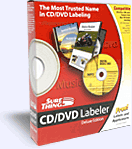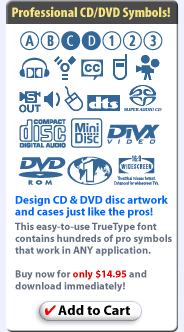Here are some design ideas for using SureThing CD/DVD Labeler
Deluxe. To read more about a particular topic, click one of the links below:
 |
This is referred to as a "sound mode icon," and this
one in particular indicates the disc contains 1-channel Dolby Digital audio (mono).
A mono channel is often used for DVD content such as director commentary.
|
 |
Disc contains 2-channel Dolby Digital audio (stereo).
|
 |
Disc contains 3-channel Dolby Digital audio (surround).
|
 |
Disc contains 5.1 Dolby Digital audio, i.e., surround with a
LFE (low-frequency effects) channel.
|
 |
Dolby Digital Surround EX, a system co-developed by Dolby and
Lucasfilm, was first used theatrically for Star Wars: Episode 1. Dolby Digital
Surround EX soundtracks contain 5.1 channels of discrete audio, plus an additional
matrix encoded surround channel. These DVDs are compatible with all playback
systems and provide an enhanced surround effect when used with a Surround EX
enabled system.
|
 |
6.1 channel surround from DTS, a competitor to Dolby. This format
adds a rear center speaker to the surround sound package found on selected music
and movie discs.
|
 |
THX EX is 7.1 channel surround from Lucasfilm. There aren't
many movies encoded with 7.1 (all the new Star Wars films are), nor many preamps
to play it. You'd also have to add more speakers to your system. If you have
such a setup, can we come over?
|
 |
DTS was developed for “Jurassic Park” in 1993 and
is the main competitor to Dolby Digital in the AV market. DTS’ advantage
over Dolby is its 3:1 compression versus 12:1. Most current receivers and preamps
are capable of playing both Dolby 5.1 and DTS surround DVDs.
|
 |
Stands for Meridian Lossless Packing, a lossless compression
scheme used on DVD-Audio to get the highest resolution surround sound and stereo
music from a DVD disc. DVD-Audio sounds better than the 16-bit audio on CDs.
|
 |
The disc is playable only in DVD players from region 1, i.e.,
North America. There are eight regions (seven geographical and an eighth reserved
for airlines, cruise ships, etc.).
|
 |
The disc is playable in DVD players from all regions of the
world.
|
 |
NTSC stands for the National Television Systems Committee, and
is the color video standard used in North America, Canada, Mexico, and Japan.
NTSC uses 525 horizonal lines of which only 487 make up the active picture. It's
an inferior video standard compared to PAL (below).
|
 |
PAL stands for Phase Alternating Line, and is the TV standard
used in Europe and much of Asia. It was designed to correct problems in the NTSC
system. PAL uses 625 horizontal lines, of which 576 are used for the picture.
In other words, it has roughly one sixth more resolution than NTSC, resulting
in better color and sharper resolution.
|
 |
The disc contains video content with an aspect ratio of 1.33:1
(or 4:3). This is the basic dimension of a television monitor.
|
 |
The disc contains video content with an aspect ratio of 1.78:1
(or 16:9), also referred to as "anamorphic widescreen." In addition
to 1.78:1, there are other anamorphic screen ratios such as 1.66:1, 1.85:1 and
2.35:1 and 2.39:1 which you might see listed on DVDs.
|
 |
The disc contains closed captioning for the hearing impaired.
|
 |
We're all familiar with the DVD logo, and its many variants
(ROM, Video, Audio, etc.).
|
 |
You haven't seen any discs with this symbol yet, but you will
sometime in 2005. It stands for High Definition/High Density DVD, the next-generation
optical disc format, developed by an industry consortium led by Toshiba and NEC.
HD-DVDs are capable of storing 15GB of data, and use the MPEG4 codecs for compression.
|
 |
Another next-generation optical disc format that hopes to replace
DVD. Developed by Philips and Panasonic, Blu-ray Disc will be a competitor to
HD-DVD. Blu-ray Disc allows 29GB of data (nearly twice HD-DVD), but it uses the
MPEG2-based codecs, which are not as efficient as MPEG4. The latter can reduce
file size by two thirds, meaning a 15GB HD-DVD disc can hold 180 minutes of high-definition
video, whereas a 29GB Blu-ray disc can hold 132 minutes. Will one format beat
out the other to become the replacement for DVD? Or will they co-exist? Stay
tuned... |





